Review Samsung E300/E310

Live pictures
Standard kit:
- Phone
- Manual
- Handsfree headset
Samsung has always distinguished in its aspiration for producing
maximum functionally similar phones that differ only in some functions.
Qualitative improvements concerned changes in the screen, polyphony,
the appearance of some function or its revision. It would seem that
such models cannot get popular and have good sales but the experience
of Samsung denies that. The key to success of new models is in accurate
functionality, active advertising support and general growth of
trust in Samsung brand. After getting in the market Samsung's models
do not become bestsellers at once (an exclusion is only
Samsung C100, high-price models). If to speak about middle-price
segment, then we should admit that a company and its products get
the highest response in six months after beginning of sales. Let's
refresh in our memory the example of
Samsung S300, the model has still been popular and sets the
main part of Samsung sales in this segment. The model can be considered
a long-liver, its rivals came and went away and it still remained.
A new model E300 will get into the same class as Samsung S300 did
at the moment of its production. So generally we can speak about
a whole family of devices -
E300, E310,
E330. They all differ in appearance (not very remarkable changes in
the design of front panel),
different markets and the dates of getting into them. For instance,
E310 is an originally operator model and it will be possible to
get it in autumn only via Vodafone network. In the beginning of
the next year it will be available in the free market with original
software (similar to E300). We will speak about non-operator version
of the device further, and will give several photos of the screen
of E310 for you to understand the difference in software.

If to continue compareness between S300 and E300 we would like
to note that the last one has an improved outer colour screen, a
possibility to assign phtos to names in the phone book and display
them on outer screen during the call appeared. It's quite evident
that middle-class device should be equipped with a camera by default,
the model being cosidered has VGA camera.

The device looks like a classic clamshell with rounded edges,
an oval converging to the bottom. The design of the device is so
traditional that it looks similar to so many models already represented
on the market. The only things that make it different are a plastic
insertion of another colour around the screen and camera gap in
the middle of the body. Two service light-emitting diodes on each
side of the outer screen seem a good solution in E310. They are
a kind of eyes that start shimmering in different colours during
calls and events.

The presence of outer antenna doesn't seem attractive any more
but is acceptable in middle-class products. The antenna makes no
troubles, the dimensions of the phone are quite convenient to carry
it as you like (83.5x46.5x22 mm). The weight of the device is also
typical for its class (85 g). At the same time the device can be
felt in the hand, its mass is focused in a small capacity that seems
to be a plus to some users. The majority of users won't notice it
anyway if not attracting attention to this peculiarity of the body.
A twin button for volume level adjustment is on the left side,
a slot for attaching handsfree headset is on the upper end (closed
with a plastic curtain sliding along guiding ways). A special button
for camera and IrDA gap are on the right side. Interface connector
is traditionally on the bottom end, it's standard and concures with
previous models by the company. A hole for fixing a strip is on
the top.

The phone is equipped with TFT 65K outer screen, which has the
resolution of 96x64 pixels. A service line with icons and two text
lines can be displayed on it. The picture can be viewed clearly
in the room but not in sunny day. Taking into account that a photo
of the caller is displayed on the outer screen, its behaviour becomes
critical in the sun. In general it's possible to say that the phone
takes intermediate position between ones with monochrome and colour
outer displays. Naturally being inferior to monochrome devices it
beats any model with colour outer screen, a picture is viewed better
then. Speaking about this fact we should take into consideration
that Samsung uses its own screens in its phones.



Its easy to open the clamshell with one hand. Inner screen has
the resolution of 128x160 pixels that allows to display up to 7
text lines and 3 service lines. It shows up to 65000 colours (TFT),
they are bright and vivid. As for the quality of the screen the
phone is one of the best in its class and is a bit loses to ones
made by Sharp used in Motorola v300,
v500,
v600.
And it's possible to say that considering the quality of the screen
this model is evidently higher than ones of the middle class and
is one of the best. The screen fades in the sun but information
still can be read if you choose a right angle.

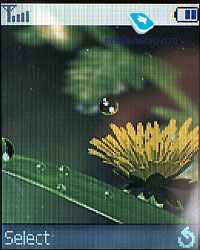
The keyboard is made of plastic, keys have middle size and the
distance between them is convenient. It is comfortable to work with
and makes no troubles. The same keyboard was used in a number of
products by Samsung and gave no rise to unfavourable criticism.
The backlighting is blue and not even, the letters are small and
can be viewed clearly not in all lighting conditions.

The battery is also used as a back side of the phone. Battery
type is Li-Ion, 850 mAh. According to the manufacturer it works
about 200 hours in the standby mode and up to 3 hours in the talk
mode. In Moscow (MTS network) the device worked for 3-4 days in
case of 45 minutes of talk time and 30-40 minutes of game playing.
This model has an improved energy consumption like other new devices
by Samsung, the phones work almost two times longer than previous
models with the same battery capacity. Full charging time is about
2 hours.
Menu
The first thing you come across with is the third way of representing
the main menu - with icons, that means three rows with three icons
in each. It appeared in addition to standard traditional two lines
(both are vertical). The advantage of the interface is the following:
now before choosing this or those way of displaying the menu you
can have a preliminary view.
 
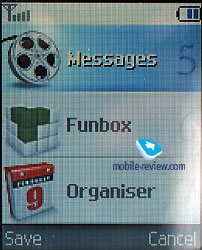 
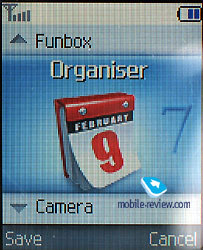
Many users reproached Samsung with the fact that navy button doesn't serve as "OK"
button also. It was necessary to move to the left soft key or push the navy button to the right.
The question doesn't rise when speaking about this model. A blue key integrated into
the navy button serves as "OK".

Navigation with the help of digital series, the device doesn't
differ from other Samsung's phones in this parameter.
Phone book. Pressing the right soft key you can
switch to the phone book from the standby mode. You find yourself
in the list of items and the first one is "Search for a name". The
phone allows to view the internal memory at the same time with SIM-card
memory. When you save numbers in internal memory you can enter several
numbers for a name (mobile, home, office, fax and other) e-mail
address and finally assign the user to a group. At the same time
you can create up to 10 groups and name them as you like. Own melodies,
pictures and sound alert for SMS can be set for groups. You can
store up to 2000 numbers in the internal memory.
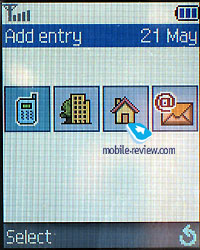 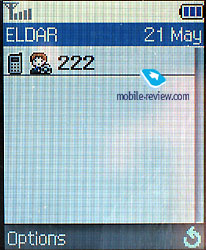
 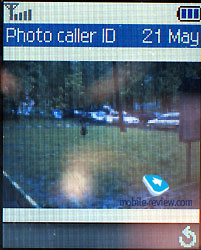
There is a possibility to assign a photo not only to a name but to a number also.
It has to be a photo taken using an integrated camera but not any other graphical file.
The photo is displayed both on the inner and outer screens.
Messages.
The phone supports EMS and concatenated messages (up to 918 characters).
As a corollary there is a set of 22 small pictures, animation (24 pictures),
a possibility to integrate a melody into a message. Internal memory allows to keep 200
messages in addition to SIM-card memory.
 
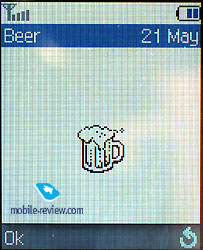 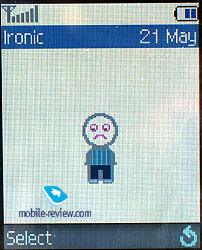
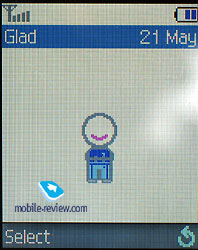
When typing a message you can rise a submenu that allows to switch languages.
It means that a message can be typed in several languages. An interesting
peculiarity is that predictive text input is supported for all the languages of
localized menu. Thus if having menu in Russian you'll be able to use
Russian T9.
Multimedia messages are kept in separate submenu, this easier interface
is different from the one in other new models. You can create several pages,
100 KB is the maximum size for outgoing message and 45 KB for incoming.
1400 KB of memory are for MMS.
Call records. Everything is ordinary here - there
is call log of the last 20 outgoing, incoming and missed calls.
Total call time is not registered though outgoing and incoming calls
duration is present in separate mode.
Sounds. The phone has 64-tone polyphony that sounds
not very bad. There are several modes of call signal. They are only
sound, only vibrating alert or first vibrating then a melody. Other
settings are standard, it is possible to choose SMS, MMS alert,
adjustment of minute minder during a call, silent call mode (vibra
or complete silence). You can choose own tones for opening and closing
the clamshell, only two are preset.
Settings. There is a possibility to set welcome
note but screen settings attract more attention. So, there is a
possibility to set animation as a wallpaper (10 pictures are preset).
You can choose font style and colour in the standby mode. There
are four headbands and wallpapers in different colours for outer
screen.
 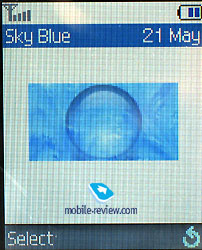
 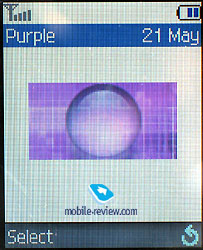
 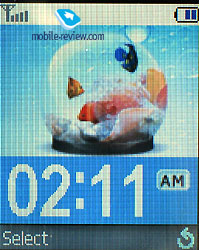
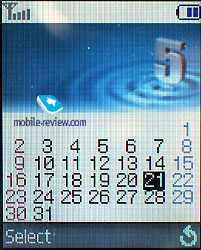 
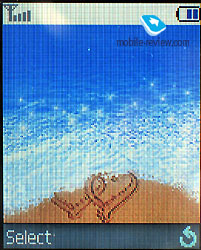 
 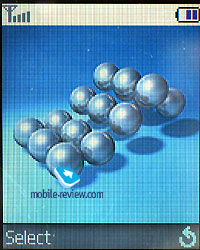
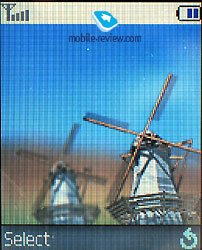 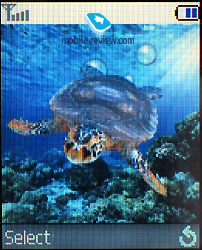
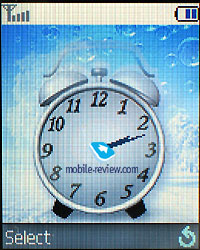 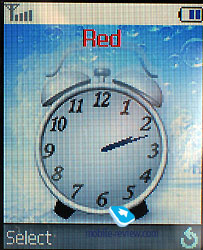
It is interesting that backlighting can be set for a period of
time and a range of values is rather wide (from 15 seconds to 10
minutes). Maximum value is for those who likes to play games for
a long time, there will be no need in touching buttons to activate
backlighting.

Organizer. There is a possibility to set a new
memo immediately. Any memo can contain up to 40 characters. There
are no separate categories for events. You just enter an event for
a current day and that's all. There is a possibility of keeping
several events for a day and a go-to function to a neccessary date.
The calendar displays the current month.
There is also world time function in the phone, no any peculiarities here.
The same can be told about a calculator, currency converter.
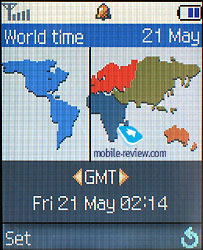 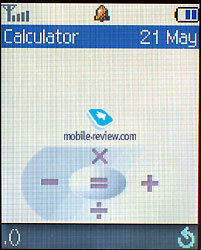

Alarm clock can be set for certain days of the week, the phone
can be switched on automatically. Then even a turned off phone will
work at the preset time.
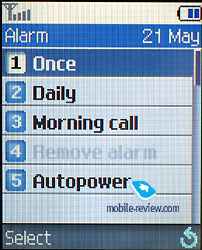
To-do list allows to set priorities for entered notes, everything is standard.
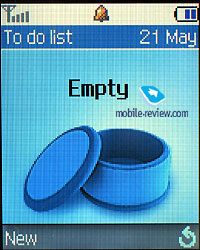 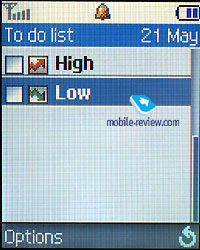
Dictaphone allows to make up to 5 records for 30 seconds each, total memory size for them is
100 KB.
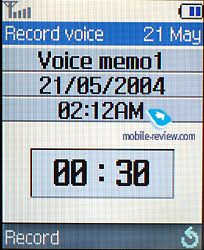 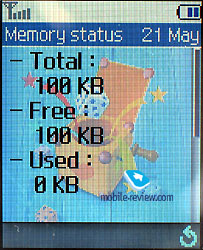
Network Services. The settings connected with
redirection and things like that do not represent anything special.
We should point out that Samsung E300 is the tri-band phone, though
official resources declared another information. There is a possibility
to choose the third band (GSM 1900), it's traditionally done manually.
Fun Box.
Wap browser is "hiden" here, in this model it is 2.0 and allows to view colour images.
The device supports batch communication (GPRS 4+2), that makes browsing not
very expensive.

All your received pictures, images and melodies are kept in folders Sounds and Images.
Four games are preinstalled, they are BubbleSmile (a favourite
version of bubbles), Fun2Link (game for logic), Ultimate Golf, Mobile
Chess. They cannot be deleted.

512 KB of memory are for Java and besides that 716 KB are for
images and pictures.
Camera. VGA-camera is integrated into the phone
and it would not attract any attention if the developers have not
changed its interface. First, dealing with it became much easier,
there is no need to go to the menu, all the main functions are available
from the shooting mode (when the picture is displayed on the screen).
You can set contrast level, enlarge picture (8x digital zoom), change
resolution. Among standard functions there is a timer, frames (a
wide range, some are really not bad), effects (negative, sepia,
grey tone, poster). The phone supports MultiShot function in two
speeds, normal and high. Each series can contain 6, 9, and 15 pictures.


The camera supports the following resolutions - VGA (640x480), QVGA
(320x240), QQVGA(160x120), Mobile (176x120). Also there are four types of data
compression, file quality (Economy, Normal, Fine, Super Fine). 4 MB of memory
are intended for photos, average size of a photo with high resolution and
medium compressoin quality is about 30-40 KB. In its quality the camera practically doesn't
differ from a similar one in Samsung
E700.
You can get acquainted with the quality of the photos
here.
There is a possibility to view decreased pictures from photo album
and load photos to PC with the help of special software included
into the delivery kit, but it is absent for the moment.
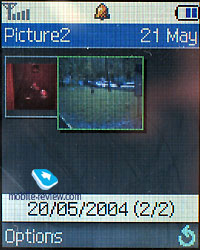 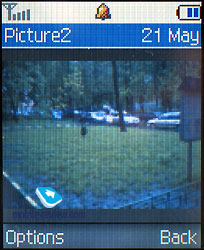
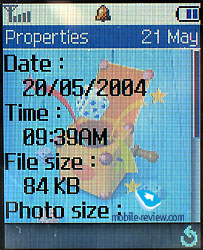 
The camera allows to record short clips up to 30 seconds in duration
(without sound). The same memory as for photos is used for video
and is shared dynamically. I didn't manage to transfer video to
PC because of the lack of corresponding software and transmission
via IrDA is not supported either (the same for photos). The quality
of clips is not bad and almost ideal for extra function even though
the image still remains a bit twitched.
Samsung Е310. This operator version of E300 has
a typical menu for Vodafone that loses to original one almost in
everything. Another division of menu items, poor design, a list
of musical files is shorter. Generally speaking we can admit that
the operator version is the worst version of the phone. Though E310
is more interesting in design than E300.
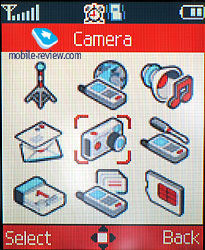 
 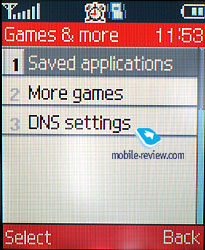
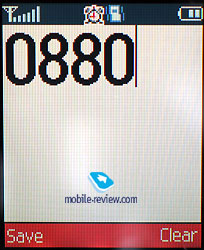
Impressions
The quality of connection is typical for Samsung. Its 40-tone
polyphonic call signal has rather high volume and if it is set on
the maximum, the loud speaker can fail, then you'll hear insignificant
wheezes. The phone is heard well in the street but being in a disco
you'll certainly miss a call. The power of vibrating alert is average.
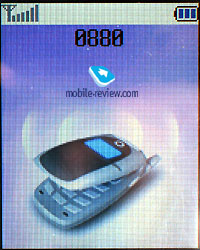 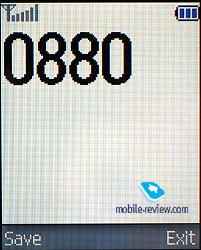
In the line of Samsung products an analog for this model is Samsung
E600, the devices are very similar in features. The advantage
of E300 is in its possibility to display the picture of the caller
on the outer screen, a bit larger body (the keypad is correspondingly
more convenient). At the moment other manufacturers do not have
any straight rivals for E300, it is unique (though phones made by
Pantech have similar characteristics, for example G500).
In general the model is good and that means it will become popular
approximately in the beginning of the next year when its price gets
lower. First shipments of E300 will start in August and the device
will be sold widely. E310 will enter the market in September. At
first E300 will cost about $260-280.
Ringtone samples (mp3, 645 KB)
Eldar Murtazin (eldar@mobile-review.com)
Translated by Maria Mitina (maria.mitina@mobile-review.com)
Published — 20 August 2004
Have something to add?! Write us... eldar@mobile-review.com
|
































































